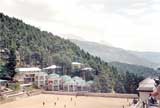Land grows with children

the main compound of the TCV is nestled in the foothills of the Himalayas.
His Holiness the Dalai Lama arrived in Dharamsala in 1960. Shortly after his arrival, he sent officials to the refugee camps scattered throughout India to study the situation of the Tibetan children.
Immediately, 51 children were brought to Dharamsala from Jammu, one of the largest Tibetan refugee camps.
The Dalai Lama charged his family and his eldest sister, with the care of these 51 children. The Nursery for Tibetan Refugee Children, as it was called at that time, marked the birth of the Tibetan Children’s Villages, a separate and distinct system of education for Tibetan refugee children in India.
There are 85 schools for Tibetan children in India, each of which fall into one of three categories: those of the Central Tibetan Schools Administration, those of the Tibetan Government in Exile’s Department of Education and those which comprise the Tibetan Children’s Villages. The Central Tibetan Schools Administration is a function of the Indian government, a school system for Tibetan refugee children and modeled after the Indian method of education. The efforts of the Indian government were acknowledged by the Dalai Lama. However, the Dalai Lama desired an educational system administered by Tibetans and attended exclusively by Tibetan children. Thus the Nursery for Tibetan Refugee Children was metamorphosed into the Tibetan Children’s Villages.
The Nursery was initially an abandoned British bungalow, not capable of accommodating the 51 Jammu children. As Tibetan parents learned of the Nursery and the educational aspirations housed therein, an influx of Tibetan children arrived to overwhelm the already lacking provisions and facility.
The Indian government purchased two buildings to provide for the growing student population in the Nursery, the Conioum House and the Egerton House, the latter of which is the current site of the main TCV in Dharamsala, northern India.
The school system envisioned by the Dalai Lama and located a few kilometers from Dharamsala, India; functional capital of the Tibetan government in exile, formally became the Tibetan Children’s Villages in 1974. This was the same year the system was officially recognized as a charitable organization by the Indian government.
Jetsun Pema, sister of the Dalai Lama, brought the model of the Pestolozzi Schools to the TCV system.
Pema was educated in Catholic girls schools in India and later in Switzerland, and assumed control of the TCVs following the death of Tsering Dolma, the eldest sister who mothered the school when it was only a nursery. Pema refused to place the children in dormitories, instead placing them in homes, with a “house mother” and an array of children of various ages and sex, who could interact as family members. Pema originally planned for a maximum of 25 children per “family”. Today, however, there are 35 to 40 children in each home and 40 homes within the TCV at Dharamsala. There are 15,000 children in the Tibetan Children’s Villages today, which accounts for about half of the children in Tibetan education in exile.
Your donation will support the student journalists of Missouri Southern State University. Your contribution will allow us to purchase equipment and cover our annual website hosting costs.



























